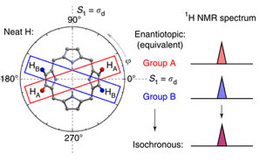Research Abstract
ジアステレオマーの形成に基づかない参照系におけるキラリティーと光学純度のNMR分光検出
キラル化合物の光学純度は治療作用の活性を決める主要因子である。本稿で著者らは、対称なアキラル分子を光学分割剤として用いて鏡像体過剰率を決定する多目的NMR法を報告する。この方法は、検体との錯体形成に基づいており、ジアステレオマーは形成されない。
NMR spectroscopic detection of chirality and enantiopurity in referenced systems without formation of diastereomers
2013年7月17日 Nature Communications 4 : 2188 doi: 10.1038/ncomms3188

キラル化合物の鏡像体過剰率は、その生理活性や薬効を決める重要なパラメーターである。NMRを用いて鏡像体過剰率を高速測定するための現在のパラダイムは、キラル検体とキラル分子からなる光学分割剤間のジアステレオマー錯体の形成に基づいており、鏡像対称関係のない種が(少なくとも)2つ形成される。今回我々は、光学分割剤として対称的なアキラル分子を用いて鏡像体過剰率を決定する効果的な方法を報告する。この方法では、ジアステレオマーが形成されず、キラル検体とアキラルな光学分割剤が高速交換しながら錯体形成することに基づいている。アキラルな分子からなる光学分割剤としてN,N’二置換オキソポルフィリノーゲンを用いることによって、この手法は極めて汎用的になり、カルボン酸、エステル、アルコール、保護アミノ酸などさまざまなキラル検体に適用可能である。キラルセンシングの機構を説明するモデルは、鏡像体過剰率と、1H NMRスペクトルに誘起される化学シフトの非等価性の大きさが、原理上、常に直線関係を示すことを表している。
Jan Labuta1, 石原 伸輔1, Tomáš Šikorský2, Zdeněk Futera3*, 春藤 淳臣1**, Lenka Hanyková4, Jaroslav V. Burda3, 有賀 克彦1, 5 & Jonathan P. Hill1, 5
- 独立行政法人物質・材料研究機構 国際ナノアーキテクトニクス研究拠点
- マサリク大学 CEITEC(チェコ共和国)
- カレル大学 Faculty of Mathematics and Physics, Department of Chemical Physics and Optics(チェコ共和国)
- カレル大学 Faculty of Mathematics and Physics, Department of Macromolecular Physics (チェコ共和国)
- 独立行政法人科学技術振興機構 CREST
*現所属先:慶応義塾大学 理工学部
**現所属先:九州大学大学院 工学研究院 応用化学部門
Enantiomeric excess of chiral compounds is a key parameter that determines their activity or therapeutic action. The current paradigm for rapid measurement of enantiomeric excess using NMR is based on the formation of diastereomeric complexes between the chiral analyte and a chiral resolving agent, leading to (at least) two species with no symmetry relationship. Here we report an effective method of enantiomeric excess determination using a symmetrical achiral molecule as the resolving agent, which is based on the complexation with analyte (in the fast exchange regime) without the formation of diastereomers. The use of N,N′-disubstituted oxoporphyrinogen as the resolving agent makes this novel method extremely versatile, and appropriate for various chiral analytes including carboxylic acids, esters, alcohols and protected amino acids using the same achiral molecule. The model of sensing mechanism exhibits a fundamental linear response between enantiomeric excess and the observed magnitude of induced chemical shift non-equivalence in the 1H NMR spectra.

